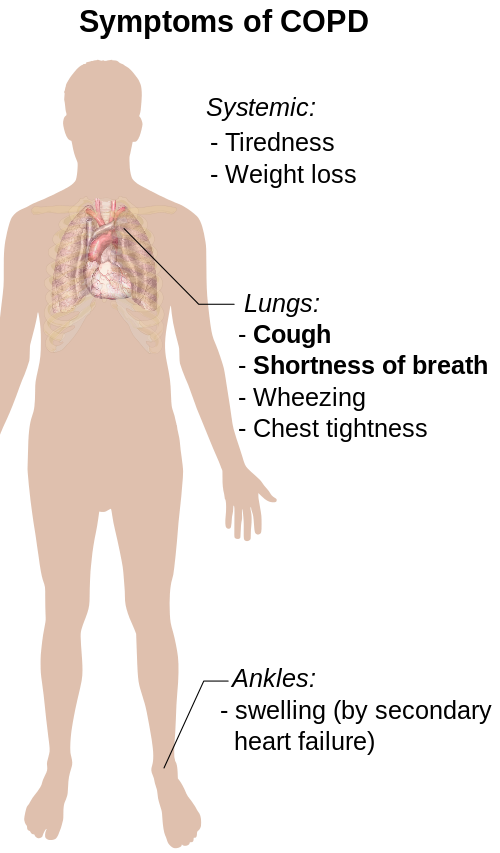Difference Between COPD and OSA
What is COPD (Chronic Obstructive Pulmonary Disease) and OSA (Sleep Apnoea)?
COPD and OSA are both highly prevalent disorders. One in ten people with obstructive sleep apnoea (OSA) also suffer from COPD (chronic obstructive pulmonary diseases) which is termed as overlap syndrome. This implies that both disorders occur simultaneously. Both COPD and OSA are associated with same molecular and physiological consequences, such as systemic inflammation, that lead to cardiovascular issues and pulmonary hypertension. However, there are many points of distinction between both the disorders.

COPD (Chronic Obstructive Pulmonary Disease)
COPD is also known as chronic obstructive pulmonary disease and is an umbrella term for the health disorders like chronic asthma, emphysema and chronic bronchitis and. All these diseases block airflow and make it difficult to breathe. COPD cannot be reversed. Symptoms include wheezing, shortness of breath or a chronic cough.

OSA (Sleep Apnoea)
Obstructive sleep apnoea (OSA) is the most common type of sleep disorder. It is defined as the intermittent airflow obstruction while sleeping. When someone with Obstructive sleep apnoea is asleep, the tissues in their air passage relax and can obstruct the airways. As a result, people stop breathing until the brain wakens them to start breathing again. Symptom includes snoring and day time sleepiness.
Difference Between COPD (Chronic Obstructive Pulmonary Disease) and OSA (Sleep Apnoea)
-
Definition
COPD (Chronic Obstructive Pulmonary Disease)
It is defined as the damage caused to the lungs by a group of diseases which makes breathing difficult.
OSA (Sleep Apnoea)
It is a common type of sleep apnoea and is caused by complete or partial blockage of the upper airway.
-
Causes
COPD (Chronic Obstructive Pulmonary Disease)
- Tobacco smoking is the most common cause of chronic COPD
- Exposure to severe and persistent pollution (dust, chemicals, fumes, poorly vented cooking fires)
- Emphysema characterised by damage to the small, sac like units of the lung that deliver air into the lungs and eliminate the carbon dioxide.
- Chronic bronchitis
- Genetic factors including alpha 1 -antitrypsin deficiency.
OSA (Sleep Apnoea)
In adults the main causes of OSA include excess weight and obesity, associated with soft tissue of the mouth and throat. While sleeping, tongue and throat muscles are more relaxed and the soft tissues result in obstruction of the air passage. In small kids, the causes of OSA include enlarged tonsils or adenoids and dental problem like a large overbite. Some other causes include a tumour in the airway, and birth abnormalities like Pierre-Robin syndrome and Down syndrome.
Other causes include;
- Ageing
- Endocrine disorders
- Body Mass Index
- Abnormalities of the head and neck
- Genetics
- Gender
- Medications
- Post-menopause
- Alcohol
- Race
- Large neck size
- Smoking
-
Types
COPD (Chronic Obstructive Pulmonary Disease)
Types include
- Chronic Bronchitis
- Obstruction of small air passage and inflammation of major air channel
- Long term cough with mucus
- Emphysema
- Damage to the lungs over time
- Destruction of tissues and permanent enlargement of air spaces distal to terminal bronchioles
- Elasticity of lungs is reduced
- Alpha1 – Antitrypsin deficiency
- Genetic disorder
- Results in destruction of alveoli
- Material for safeguarding produced in the lungs and transported to lungs to help combat swelling
OSA (Sleep Apnoea)
Types include
- Obstructive Sleep Apnoea
- It occurs when throat muscles relax
- Central Sleep Apnoea (CSA)
- This occurs when your brain does not deliver proper signals to the muscles that control breathing.
- Mixed or Complex Sleep Apnoea
- This is also termed as treatment-emergent central sleep apnoea, which happens when an individual has both OSA and CSA.
-
Symptoms
COPD (Chronic Obstructive Pulmonary Disease)
- Wheezing
- Lack of energy
- Swelling in feet, legs or ankles
- Shortness of breath
- Repeated respiratory infections
- Frequent coughing (with or without mucus)
- Whistling or squeaky sound during breathing
OSA (Sleep Apnoea)
- Loud and frequent snoring
- Alleviated libido
- Morning headache
- Restless sleep
- Daytime fatigue or sleepiness
- Pauses or absence of breathing
- Weight loss
- Dry throat
- Mood swings
- Awakening with a dry mouth
-
Treatment & Surgery
COPD (Chronic Obstructive Pulmonary Disease)
- Bronchodilators – These relax the muscles around your air passages to let more air into your lungs.
Short-acting bronchodilators – These work quickly and include
- Ipratropium (Atrovent)
- Ipratropium bromide & albuterol (Combivent)
- Albuterol (Ventolin HFA, ProAir HFA)
- Levalbuterol (Xopenex HFA)
Long-acting bronchodilators: These work for up to 12 hours. These include
- Aclidinium (Tudorza Pressair)
- Salmeterol (Serevent)
- Formoterol (Foradil, Performist)
- Tiotropium (Spiriva)
- Arformoterol (Brovana)
- Indacaterol (Arcapta)
- Steroids – These reduce swelling in your airways. Examples of inhaled steroids include:
- Fluticasone (Flovent HFA, Flonase)
- Budesonide (Entocort, Pulmicort, Uceris)
- Phosphodiesterase-4 (PDE-4) Inhibitors like roflumilast (Daliresp) can help with severe COPD symptoms.
- Theophylline – This drug works like a bronchodilator and is not pricey. It helps lungs to function better.
- Antibiotics – Antibiotics kill the bacteria incase there is an infection. Infection can make the COPD symptoms worse.
- Pulmonary Rehabilitation – The program helps in managing COPD. It helps improve your quality of life.
- Oxygen Therapy – Severe COPD blocks your airways and reduces oxygen levels in your blood. Oxygen therapy by mask or prongs, elevates these levels to help you stay healthy and active.
- Vaccinations
- Surgery – Bullectomy, Lung volume reduction surgery, Lung transplant.
OSA (Sleep Apnoea)
- Lifestyle changes – Weight loss, quit smoking, regular exercises and do not sleep on your back.
- Therapies
- Positive airway pressure – In this treatment, a machine will deliver air pressure through a piece that is fitted into nose. This therapy reduces daytime sleepiness.
- Mouthpiece (oral device) – Oral appliances are helpful for people with mild or moderate obstructive sleep apnea. These appliances alleviate your sleepiness and improve quality of life. These devices also help in keeping your air passage open by bringing your jaw forward and help in breathing.
- Surgery or other procedures
- Surgical removal of tissue (Uvulopalatopharyngoplasty (UPPP)
- Upper airway stimulation
- Jaw Surgery
- Surgical opening in the neck
- Implants
Summary of OSA Vs. COPD in a Tabular Form
The points of difference between COPD (Chronic Obstructive Pulmonary Disease) and OSA (Sleep Apnoea) have been summarized below:

- Difference Between Global Warming and Greenhouse Effect - May 18, 2024
- Difference Between Vaccination and Immunization - March 3, 2024
- Difference Between Selective Mutism and Autism - February 25, 2024
Search DifferenceBetween.net :
Leave a Response
References :
[0]Image credit: https://commons.wikimedia.org/wiki/File:Symptoms_of_COPD.svg
[1]Image credit: http://www.pdhealth.mil/sites/default/files/images/styles/square_300/public/Nightmares_blog-fullpage.jpg?itok=0qtC_rDu
[2]Balk, E. M., Chung, M., Moorthy, D., Chan, J. A., Patel, K., Concannon, T. W., ... & Chang, L. K. W. (2012). Future Research Needs for Diagnosis of Obstructive Sleep Apnea.
[3]Brouillette, R. T., Fernbach, S. K., & Hunt, C. E. (1982). Obstructive sleep apnea in infants and children. The Journal of pediatrics, 100(1), 31-40.
[4]Calverley, P. M. A., & Georgopoulos, D. (2006). Chronic obstructive pulmonary disease: symptoms and signs. European Respiratory Monograph, 38, 7.
[5]Fleetham, J. A. (2003). Is chronic obstructive pulmonary disease related to sleep apnea-hypopnea syndrome? American journal of respiratory and critical care medicine, 167(1), 3.
[6]Gillissen, A., & Seeger, W. (2002). Chronic obstructive pulmonary disease: treatment. Deutsche medizinische Wochenschrift (1946), 127(10), 510-513.
[7]Motamedi, K. K., McClary, A. C., & Amedee, R. G. (2009). Obstructive sleep apnea: a growing problem. The Ochsner Journal, 9(3), 149-153.
[8]Murphy, T. F., & Sethi, S. (2002). Chronic obstructive pulmonary disease. Drugs & aging, 19(10), 761-775.
